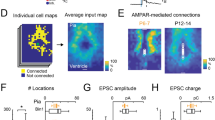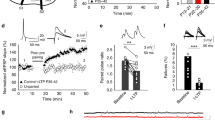Abstract
Because LTP and LTD may contribute to experience-dependent plasticity, a prominent hypothesis is that developmental changes in the biophysical and molecular properties of NMDA receptors (NMDARs) may regulate the duration of critical periods1,2,3,4,5,6,7. Here we report that susceptibility to LTP at thalamocortical synapses in early postnatal mouse slices is lost at a time point when the duration of NMDAR-mediated excitatory post-synaptic currents (NMDAR EPSCs) is not significantly altered. However, changes in the subunit composition of NMDARs, as defined pharmacologically, correlate strongly with the loss of the ability to generate LTP.
This is a preview of subscription content, access via your institution
Access options
Subscribe to this journal
Receive 12 print issues and online access
$209.00 per year
only $17.42 per issue
Buy this article
- Purchase on Springer Link
- Instant access to full article PDF
Prices may be subject to local taxes which are calculated during checkout



Similar content being viewed by others
References
Carmignoto, G. & Vicini, S. Science 258, 1007–1011 (1992).
Hestrin, S. Nature 357, 686–689 (1992).
Gold, J. I. & Bear, M. F. Proc. Natl. Acad. Sci. USA 91, 3941–3945 (1994).
Crair, M. C. & Malenka, R. C. Nature 375, 325–328 (1995).
Fox, K., Henley, J. & Isaac, J. Nat. Neurosci. 2, 297–299 (1999).
Quinlan, E. M., Philpot, B. D., Huganir, R. L. & Bear, M. F. Nat. Neurosci. 2, 352–357 (1999).
Shi, J., Aamodt, S. M. & Constantine-Paton, M. J. Neurosci. 17, 6264–6276 (1997).
Monyer, H., Burnashev, N., Laurie, D. J., Sakmann, B. & Seeburg, P. H. Neuron 12, 529–540 (1994).
Monyer, H. et al. Science 256, 1217–1221 (1992).
Tovar, K. R. & Westbrook, G. L. J. Neurosci. 19, 4180–4188 (1999).
Tang, Y. P. et al. Nature 401, 63–69 (1999).
Williams, K. Mol. Pharmacol. 44, 851–859 (1993).
Kirkwood, A., Lee, H. K. & Bear, M. F. Nature 375, 328–331 (1995).
Sprengel, R. et al. Cell 92, 279–289 (1998).
Husi, H., Ward, M. A., Choudhary, J. S., Blackstock, W. P. & Grant, S. G. Nat. Neurosci. 3, 661–669 (2000).
Acknowledgements
This work was supported by a Hitchings-Elion Fellowship from the Burroughs Wellcome Fund and Epilepsy Training Grant NS07280 (to A.L.B.) and grants from N.I.H. (R.C.M.). We thank S. Hestrin and the Malenka lab for suggestions and comments on the manuscript.
Author information
Authors and Affiliations
Corresponding author
Supplementary information
Rights and permissions
About this article
Cite this article
Barth, A., Malenka, R. NMDAR EPSC kinetics do not regulate the critical period for LTP at thalamocortical synapses. Nat Neurosci 4, 235–236 (2001). https://doi.org/10.1038/85070
Received:
Accepted:
Issue Date:
DOI: https://doi.org/10.1038/85070
This article is cited by
-
Neonatal Repeated Exposure to Isoflurane not Sevoflurane in Mice Reversibly Impaired Spatial Cognition at Juvenile-Age
Neurochemical Research (2017)
-
The decline in synaptic GluN2B and rise in inhibitory neurotransmission determine the end of a critical period
Scientific Reports (2016)
-
Modulation of the NMDA Receptor Through Secreted Soluble Factors
Molecular Neurobiology (2016)
-
NMDA receptor subunit diversity: impact on receptor properties, synaptic plasticity and disease
Nature Reviews Neuroscience (2013)
-
Arrested maturation of excitatory synapses in autosomal dominant lateral temporal lobe epilepsy
Nature Medicine (2009)



